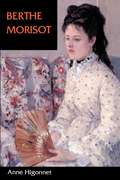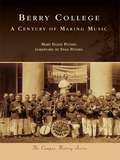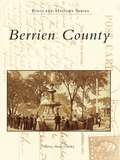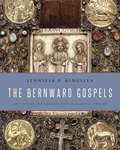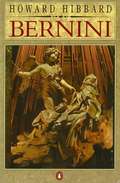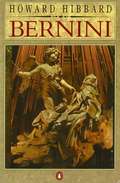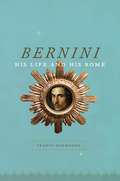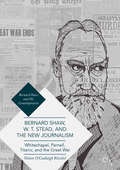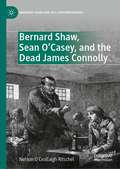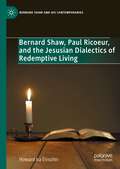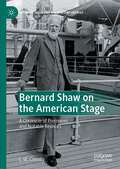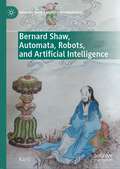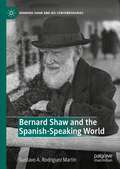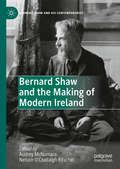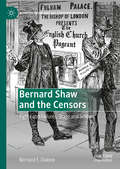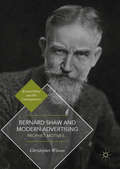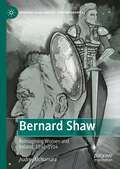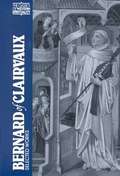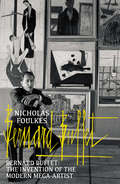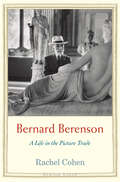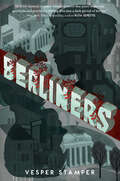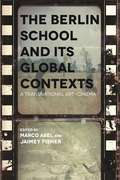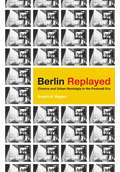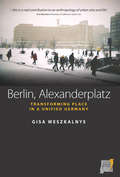- Table View
- List View
Berthe Morisot
by Anne HigonnetOf the six Impressionist painters whose first exhibition scandalized and fascinated Paris in 1874, Berthe Morisot was the only woman. She reached a pinnacle of artistic achievement despite the restraints society placed on her sex, adroitly combining her artistic ambitions with a rewarding family life. Anne Higonnet brings fully to life an accomplished artist and her world.
Berry College: A Century of Making Music
by Mary Ellen PethelThe history of Berry College is rooted in its musical culture and reflects an important part of Martha Berry's life and mission for her school. Located 60 miles north of Atlanta, Berry College began in 1902 as a small rural school, driven by Martha's desire to educate impoverished children and young adults in the foothills of the Appalachian Mountains. Through tireless fund-raising and dedication, Berry School grew from its humble beginning into an exemplary four-year liberal arts college. As Martha Berry gained widespread notoriety for her work in education, the music program performed for such guests as Henry Ford, Emily Vanderbilt, Theodore Roosevelt, and other notable leaders in business and politics. By 1948, the school's unofficial motto was "Everybody Sings at Berry." With continued success over the last 60 years, Berry's musical groups continue to gain recognition as they perform locally, nationally, and internationally.
Berrien County
by Sherry Arent CawleyAs one of the earliest developed areas of the state of Michigan, Berrien County has a rich history that appeals to the locals as well as the tourists who still enjoy the many treasures to be found there. Author Sherry Arent Cawley has compiled over 200 vintage postcards chronicling the life and times of this historic area.The historic Benton Harbor Fruit Market, Silver Beach, the mineral baths at the Whitecomb Hotel, and the House of David are all featured here in vivid postcards, some never before published, with accompanying captions. Images of Grand Beach, Niles, New Buffalo, Paw Paw Lake, and Berrien Springs offer readers a nostalgic glimpse into a Berrien County of yesteryear.
The Bernward Gospels: Art, Memory, and the Episcopate in Medieval Germany
by Jennifer P. KingsleyFew works of art better illustrate the splendor of eleventh-century painting than the manuscript often referred to as the “precious gospels” of Bishop Bernward of Hildesheim, with its peculiar combination of sophistication and naïveté, its dramatically gesturing figures, and the saturated colors of its densely ornamented surfaces. In The Bernward Gospels, Jennifer Kingsley offers the first interpretive study of the pictorial program of this famed manuscript and considers how the gospel book conditioned contemporary and future viewers to remember the bishop. The codex constructs a complex image of a minister caring for his diocese not only through a life of service but also by means of his exceptional artistic patronage; of a bishop exercising the sacerdotal authority of his office; and of a man fundamentally preoccupied with his own salvation and desire to unite with God through both his sight and touch. Kingsley insightfully demonstrates how this prominent member of the early medieval episcopate presented his role to the saints and to the communities called upon to remember him.
The Bernward Gospels: Art, Memory, and the Episcopate in Medieval Germany
by Jennifer P. KingsleyFew works of art better illustrate the splendor of eleventh-century painting than the manuscript often referred to as the “precious gospels” of Bishop Bernward of Hildesheim, with its peculiar combination of sophistication and naïveté, its dramatically gesturing figures, and the saturated colors of its densely ornamented surfaces. In The Bernward Gospels, Jennifer Kingsley offers the first interpretive study of the pictorial program of this famed manuscript and considers how the gospel book conditioned contemporary and future viewers to remember the bishop. The codex constructs a complex image of a minister caring for his diocese not only through a life of service but also by means of his exceptional artistic patronage; of a bishop exercising the sacerdotal authority of his office; and of a man fundamentally preoccupied with his own salvation and desire to unite with God through both his sight and touch. Kingsley insightfully demonstrates how this prominent member of the early medieval episcopate presented his role to the saints and to the communities called upon to remember him.
Bernini
by Howard HibbardSculptor and architect Bernini was the virtual creator and greatest exponent of Baroque in 17th century Italy. He has left his greatest mark on Rome where Papal patronage provided him with enormous architectural commissions.
Bernini
by Howard HibbardSculptor and architect Bernini was the virtual creator and greatest exponent of Baroque in 17th century Italy. He has left his greatest mark on Rome where Papal patronage provided him with enormous architectural commissions.
Bernini
by Franco MormandoSculptor, architect, painter, playwright, and scenographer, Gian Lorenzo Bernini (1598-1680) was the last of the great universal artistic geniuses of early modern Italy, placed by both contemporaries and posterity in the same exalted company as Leonardo, Raphael, and Michelangelo. And his artistic vision remains palpably present today, through the countless statues, fountains, and buildings that transformed Rome into the Baroque theater that continues to enthrall tourists today. It is perhaps not surprising that this artist who defined the Baroque should have a personal life that itself was, well, baroque. As Franco Mormando's dazzling biography reveals, Bernini was a man driven by many passions, possessed of an explosive temper and a hearty sex drive, and he lived a life as dramatic as any of his creations. Drawing on archival sources, letters, diaries, and--with a suitable skepticism--a hagiographic account written by Bernini's son (who portrays his father as a paragon of virtue and piety), Mormando leads us through Bernini's many feuds and love affairs, scandals and sins. He sets Bernini's raucous life against a vivid backdrop of Baroque Rome, bustling and wealthy, and peopled by churchmen and bureaucrats, popes and politicians, schemes and secrets. The result is a seductively readable biography, stuffed with stories and teeming with life--as wild and unforgettable as Bernini's art. No one who has been bewitched by the Baroque should miss it.
Bernard Shaw, W. T. Stead, and the New Journalism
by Nelson O'Ceallaigh RitschelThis book explores Bernard Shaw’s journalism from the mid-1880s through the Great War—a period in which Shaw contributed some of the most powerful and socially relevant journalism the western world has experienced. In approaching Shaw’s journalism, the promoter and abuser of the New Journalism, W. T. Stead, is contrasted to Shaw, as Shaw countered the sensational news copy Stead and his disciples generated. To understand Shaw’s brand of New Journalism, his responses to the popular press’ portrayals of high profile historical crises are examined, while other examples prompting Shaw’s journalism over the period are cited for depth: the 1888 Whitechapel murders, the 1890-91 O’Shea divorce scandal that fell Charles Stewart Parnell, peace crusades within militarism, the catastrophic Titanic sinking, and the Great War. Through Shaw’s journalism that undermined the popular press’ shock efforts that prevented rational thought, Shaw endeavored to promote clear thinking through the immediacy of his critical journalism. Arguably, Shaw saved the free press.
Bernard Shaw, Sean O’Casey, and the Dead James Connolly (Bernard Shaw and His Contemporaries)
by Nelson O’Ceallaigh RitschelThis book details the Irish socialistic tracks pursued by Bernard Shaw and Sean O’Casey, mostly after 1916, that were arguably impacted by the executed James Connolly. The historical context is carefully unearthed, stretching from its 1894 roots via W. B. Yeats’ dream of Shaw as a menacing, yet grinning sewing machine, to Shaw’s and O’Casey’s 1928 masterworks. In the process, Shaw’s War Issues for Irishmen, Annajanska, the Bolshevik Empress, The Tragedy of an Elderly Gentleman, Saint Joan, The Intelligent Woman’s Guide to Socialism and Capitalism, and O’Casey’s The Story of the Irish Citizen Army, The Shadow of a Gunman, Juno and the Paycock, The Plough and the Stars, and The Silver Tassie are reconsidered, revealing previously undiscovered textures to the masterworks. All of which provides a rethinking, a reconsideration of Ireland’s great drama of the 1920s, as well as furthering the knowledge of Shaw, O’Casey, and Connolly.
Bernard Shaw, Paul Ricoeur, and the Jesusian Dialectics of Redemptive Living (Bernard Shaw and His Contemporaries)
by Howard Ira EinsohnThis book explores a heretofore unremarked linkage between Bernard Shaw, the twentieth-century French thinker Paul Ricoeur, and Jesus of Nazareth. The ties that bind them are a foundational interest in the social teachings of the Nazarene and their use of a shared dialectics with respect to living the kind of compassionate life that holds out the promise in our contemporary world of achieving something approximating universal wellness on a healthy planet at peace with itself. This work argues that the three principal subjects of the study—independently of one another—used the same dialectical method to reach the same dialectically derived conclusion about how humans can live redemptively in a fractured world.
Bernard Shaw on the American Stage: A Chronicle of Premieres and Notable Revivals (Bernard Shaw and His Contemporaries)
by L. W. ConollyBernard Shaw on the American Stage is the first comprehensive study of the production of Bernard Shaw’s plays in America. During his lifetime (1856-1950), Shaw was America’s most popular living playwright; productions of his plays were outnumbered only by Shakespeare. Forty-four of Shaw’s plays were staged in America before his death, eight more posthumously. Eleven of the productions were world premieres. Bernard Shaw on the American Stage tells the story of the fifty-two premieres, which, apart from a few fragments, is his total dramatic oeuvre. The book also includes, again for the first time, production data and concise overviews of dozens of the most notable American revivals of the plays, from the 1890s to the beginning of the 2020 pandemic. Illustrations—production photographs, programmes, theatre buildings, playbills, actors’ studio portraits— inform the study throughout.
Bernard Shaw, Automata, Robots, and Artificial Intelligence (Bernard Shaw and His Contemporaries)
by Kay LiThis project is the first to explore how Bernard Shaw intersects constructively with automata, robots and artificial intelligence (AI). Shaw was born in the golden age of the automaton. His Bible on the Life Force and Creative Evolution, Back to Methuselah, was written when Karel and Josef Čapek coined the word “robot.” Shaw’s life ran in parallel with the rise of AI, and the big names in AI were his contemporaries. Moreover, empirical analyses of Shavian texts and images using AI uncovers possibilities for new interpretations, demonstrating how future renditions of his works may make use of these advanced technologies to broaden Shaw’s audience, readership and scholarship.
Bernard Shaw and the Spanish-Speaking World (Bernard Shaw and His Contemporaries)
by Gustavo A. Rodríguez MartínThis book explores, through a multidisciplinary approach, the immense influence exerted by Bernard Shaw on the Spanish-speaking world on both sides of the Atlantic. This collection of essays encompasses the reception and dissemination of his ideas; the translation of his works into Spanish; the performance history of his plays in Spain and Latin America; and Shaw’s influence on many key figures of literature in Spanish. It begins by delving into Shaw’s knowledge of Spanish literature and gauging his acquaintance with the Spanish cultural milieu throughout his tenure as an art, music, and theatre critic. His early exposure to Spanish-speaking culture later made the return trip in the form of profuse critical reception and theatrical success in countries like Spain, Argentina, Mexico, and Uruguay. This allows for a more detailed investigation into the unmistakable mark that Bernard Shaw left in the oeuvre of leading Spanish-speaking authors like Ramiro de Maeztu, Jorge Luis Borges or Nemesio Canales. This volume also assesses the translations of Shaw’s works into Spanish—while also providing a detailed publication history of these translations.
Bernard Shaw and the Making of Modern Ireland (Bernard Shaw and His Contemporaries)
by Audrey McNamara Nelson O’Ceallaigh RitschelThis book is an anthology focused on Shaw’s efforts, literary and political, that worked toward a modernizing Ireland. Following Declan Kiberd’s Foreword and the editor’s Introduction, the contributing chapters, in their order of appearance, are from President of Ireland Michael D. Higgins, Anthony Roche, David Clare, Elizabeth Mannion, Nelson O’Ceallaigh Ritschel, Aisling Smith, Susanne Colleary, Audrey McNamara, Aileen R. Ruane, Peter Gahan, and Gustavo A. Rodriguez Martin. The essays establish that Shaw’s Irishness was inherent and manifested itself in his work, demonstrating that Ireland was a recurring feature in his considerations. Locating Shaw within the march towards modernizing Ireland furthers the recent efforts to secure Shaw’s place within the Irish spheres of literature and politics.
Bernard Shaw and the Censors: Fights and Failures, Stage and Screen (Bernard Shaw and His Contemporaries)
by Bernard F. Dukore“Dukore’s style is fluid and his wit delightful. I learned a tremendous amount, as will most readers, and Bernard Shaw and the Censors will doubtless be the last word on the topic.”- Michel Pharand, former editor of SHAW: The Journal of Bernard Shaw Studies and author of Bernard Shaw and the French (2001). "This book shows us a new side of Shaw and his complicated relationships to the powerful mechanisms of stage and screen censorship in the long twentieth century.” - - Lauren Arrington, Professor of English, Maynooth University, IrelandA fresh view of Shaw versus stage and screen censors, this book describes Shaw as fighter and failure, whose battles against censorship – of his plays and those of others, of his works for the screen and those of others – he sometimes won but usually lost. We forget usually, because ultimately he prevailed and because his witty reports of defeats are so buoyant, they seem to describe triumphs. We think of him as a celebrity, not an outsider; as a classic, not one of the avant-garde, of which Victorians and Edwardians were intolerant; as ahead of his time, not of it, when he was called “disgusting,” “immoral", and "degenerate.” Yet it took over three decades and a world war before British censors permitted a public performance of Mrs Warren’s Profession. We remember him as an Academy Award winner for Pygmalion, not as an author whose dialogue censors required deletions for showings in the United States. Scrutinizing the powerful stage and cinema censorship in Britain and America, this book focuses on one of its most notable campaigners against them in the last century.
Bernard Shaw and Modern Advertising: Prophet Motives (Bernard Shaw and His Contemporaries)
by Christopher WixsonThis book charts how promotional campaigns in which Bernard Shaw participated were key crucibles within which agency and personality could re-negotiate their relationship to one another and to the consuming public. Concurrent with the rise of modern advertising, the creation of Shaw’s 'G.B.S.' public persona was achieved through masterful imitation of patent medicine marketing strategies and a shrewd understanding of the relationship between product and spokesman. Helping to enhance the visibility of his literary writing and dovetailing with his Fabian political activities, 'G.B.S.' also became a key figure in the evolution of testimonial endorsement and the professionalizing of modern advertising. The study analyzes multiple ad series in which Shaw was prominently featured that were occasions for self-promotion for both Shaw and the agencies, and presage the iconoclastic style of contemporary 'public personality' and techniques of celebrity marketing.
Bernard Shaw: Reimagining Women and Ireland, 1892–1914 (Bernard Shaw and His Contemporaries)
by Audrey McNamaraShaw emerged as a playwright in the politically charged environment of 1892, for both female suffrage and Irish independence. His plays quickly advocated for societal changes with regard to women’s roles, while expanding this advocacy into considerations of Ireland. Shaw’s engagement with marriage and union as a personal contract with nationhood have never before been considered as a methodology with which to view his work. This book demonstrates that Shaw was deeply engaged with and committed to the Irish question and to social and gender issues.
Bernard of Clairvaux: Selected Works
by Jean Leclercq Ewert Cousins G. R. Evans Bernard Of ClairvauxHere are writings of the great medieval spiritual teacher (1090-1153) who was preacher of the Crusades and founder of the Cistercians, with an introduction on the forming of Bernard's spirituality, its character and influence.
Bernard Buffet: The Invention of the Modern Mega-artist
by Nicholas FoulkesIt is said that asphyxiation brings on a state of hallucinatory intoxication...in which case the 71 year old artist who lay in his sprawling Provencal villa died happy. In the early afternoon of Monday 4 October 1999, wracked with Parkinson's, and unable to paint because of a fall in which he had broken his wrist, Bernard Buffet calmly placed a plastic bag over his head, taped it tight around his neck and patiently waited the few minutes it took for death to arrive. Bernard Buffet:The Invention of the Modern Mega-artist tells the remarkable story of a French figurative painter who tasted unprecedented critical and commercial success at an age when his contemporaries were still at art school. Then, with almost equal suddenness the fruits of fame turned sour and he found himself an outcast. Scarred with the contagion of immense commercial success no leper was more untouchable. He was the first artist of the television age and the jet age and his role in creating the idea of a post-war France is not to be underestimated. As the first of the so-called Fabulous Five (Francoise Sagan, Roger Vadim, Brigitte Bardot and Yves Saint Laurent) he was a leader of the cultural revolution that seemed to forge a new France from the shattered remains of a discredited and demoralized country. Rich in incident Buffet’s remarkable story of bisexual love affairs, betrayal, vendettas lasting half a century, shattered reputations, alcoholism, and drug abuse, is played out against the backdrop of the beau monde of the 1950s and 1960s in locations as diverse as St Tropez, Japan, Paris, Dallas, St Petersburg and New York, before coming to its miserable conclusion alone in his studio.
Bernard Berenson
by Rachel CohenWhen Gilded Age millionaires wanted to buy Italian Renaissance paintings, the expert whose opinion they sought was Bernard Berenson, with his vast erudition, incredible eye, and uncanny skill at attributing paintings. They visited Berenson at his beautiful Villa I Tatti, in the hills outside Florence, and walked with him through the immense private library--which he would eventually bequeath to Harvard--without ever suspecting that he had grown up in a poor Lithuanian Jewish immigrant family that had struggled to survive in Boston on the wages of the father's work as a tin peddler. Berenson's extraordinary self-transformation, financed by the explosion of the Gilded Age art market and his secret partnership with the great art dealer Joseph Duveen, came with painful costs: he hid his origins and felt that he had betrayed his gifts as an interpreter of paintings. Nevertheless his way of seeing, presented in his books, codified in his attributions, and institutionalized in the many important American collections he helped to build, goes on shaping the American understanding of art today. This finely drawn portrait of Berenson, the first biography devoted to him in a quarter century, draws on new archival materials that bring out the significance of his secret business dealings and the way his family and companions--including his patron Isabella Stewart Gardner, his lover Belle da Costa Greene, and his dear friend Edith Wharton--helped to form his ideas and his legacy. Rachel Cohen explores Berenson's inner world and exceptional visual capacity while also illuminating the historical forces--new capital, the developing art market, persistent anti-Semitism, and the two world wars--that profoundly affected his life.
Berliners
by Vesper StamperA riveting story about the rivalry between two brothers living on opposite sides of the Berlin wall during its construction in the 1960s, and how their complicated legacy and dreams of greatness will determine their ultimate fate.A city divided. A family fractured. Two brothers caught between past and present.Berlin, 1961. Rudi Möser-Fleischmann is an aspiring photographer with dreams of greatness, but he can't hold a candle to his talented, charismatic twin brother Peter, an ambitious actor. With the sudden divorce of their parents, the brothers find themselves living in different sectors of a divided Berlin; the postwar partition strangely mirroring their broken family. But one night, as the city sleeps, the Berlin Wall is hurriedly built, dividing society further, and Rudi and Peter are forced to choose between playing by the rules and taking their dreams underground. That is, until the truth about their family history and the growing cracks in their relationship threaten to split them apart for good. From National Book Award-nominated, critically acclaimed author-illustrator Vesper Stamper comes a stark look at how resentment and denial can strain the bonds of brotherhood to the breaking point.
The Berlin School and Its Global Contexts: A Transnational Art Cinema (Contemporary Approaches to Film and Media Series)
by Jaimey Fisher Marco Abel Lisa Haegele Robert Dassanowsky William Fech Alice Bardan Ira Jaffe Inga Pollmann Roger Cook Michael Sicinski Lutz Koepnick Chris Homewood Brad Prager Gerd Gemünden Roland Végso Hester BaerThe Berlin School and Its Global Contexts: A Transnational Art-Cinema came about in light of the Museum of Modern Art (MOMA)’s 2013 major exhibition of works by contemporary German directors associated with the so-called Berlin School, perhaps Germany’s most important contemporary filmmaking movement. Christoph Hochhäusler, the movement’s keenest spokesperson, stated that "the Berlin School, despite what the label suggests, is not a specifically German phenomenon. All over the world there are filmmakers exploring related terrain." In response to this "transnational turn," editors Marco Abel and Jaimey Fisher have assembled a group of scholars who examine global trends and works associated with the Berlin School. The goal of the collection is to understand the Berlin School as a fundamental part of the series of new wave films around the globe, especially those from the traditional margins of world cinema. For example, Michael Sicinski and Lutz Koepnick explore the relation of the Berlin School to cinema of Southeast Asia, including Apichatpong Weerasethakul and Tsai Ming-liang; Ira Jaffe and Roger Cook take a look at Middle Eastern film, with Nuri Bilge Ceylan and Abbas Kiarostami, respectively. The volume, however, also includes essays engaging with North American filmmakers like Kelly Reichardt and Derek Cianfrance as well as European auteurs like Antonioni, Tarr, Porumboiu, McQueen, and the Dardennes. Bringing German cinema into dialogue with this series of global cinemas emphasizes how the Berlin School manifests—whether aesthetically or thematically, politically or historically—a balancing of national particularity with global flows of various sorts. Abel and Fisher posit that since the vast majority of the films are available with English subtitles (and at times also in other languages) and recent publications on the subject have established critical momentum, this exciting filmmaking movement will continue to branch out into new directions and include new voices. The Berlin School and Its Global Contexts folds German-language cinema back into conversations with international as well as transnational cinema. This volume will be of great interest to scholars of German and global cinema.
Berlin Replayed: Cinema and Urban Nostalgia in the Postwall Era
by Brigitta B. WagnerScarred by the Second World War, divided during the Cold War, and turned into a massive construction site in the early postwall years, Berlin has dramatically reinvented itself in the new millennium. Film has served a neglected but important function in this transformation.In Berlin Replayed, Brigitta B. Wagner shows how old and new films set in Berlin created a collective urban nostalgia for the city's best, most inclusive, and most conciliatory pasts in the face of its renewed purpose as the all-German capital. Exploring films such as Walter Ruttmann's Berlin: Symphony of a Great City, Wim Wenders's Wings of Desire, Tom Tykwer's Run Lola Run, and Wolfgang Becker's Good Bye, Lenin!, the book establishes that these films don't merely feature the city but actively construct how viewers come to know different Berlins of the past and present. To illustrate how film has repeatedly remade the image of the city, Berlin Replayed focuses on four key periods: the golden 1920s, when the city was a major filmmaking center; the prewall 1950s, when Berlin had two ideologically opposed film industries; the politically transformative late 1980s and early 1990s; and the hyped start of the twenty-first century.By showing how films have helped revive memories of the "good" Berlin and, by extension, the "good" Germany, Berlin Replayed reveals the underappreciated but powerful role film has played in the process of unifying Germany's historical experience and bridging its physical and political divisions.
Berlin, Alexanderplatz: Transforming Place in a Unified Germany (Space and Place #1)
by Gisa WeszkalnysA benchmark study in the changing field of urban anthropology, Berlin, Alexanderplatz is an ethnographic examination of the rapid transformation of the unified Berlin. Through a captivating account of the controversy around this symbolic public square in East Berlin, the book raises acute questions about expertise, citizenship, government and belonging. Based on ethnographic fieldwork in the city administration bureaus, developers' offices, citizen groups and in Alexanderplatz itself, the author advances a richly innovative analysis of the multiplicity of place. She reveals how Alexanderplatz is assembled through the encounters between planners, citizen activists, social workers, artists and ordinary Berliners, in processes of popular participation and personal narratives, in plans, timetables, documents and files, and in the distribution of pipes, tram tracks and street lights. Alexanderplatz emerges as a socialist spatial exemplar, a 'future' under construction, an object of grievance, and a vision of robust public space. This book is both a critical contribution to the anthropology of contemporary modernity and a radical intervention in current cross-disciplinary debates on the city.
